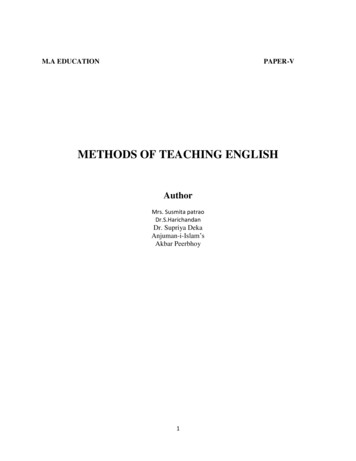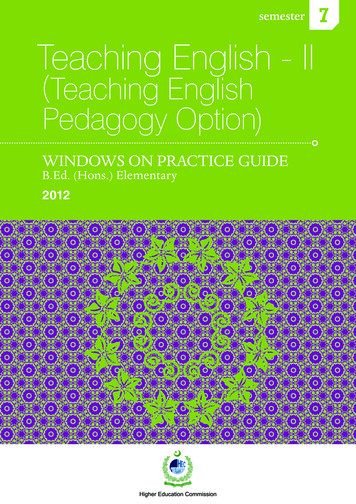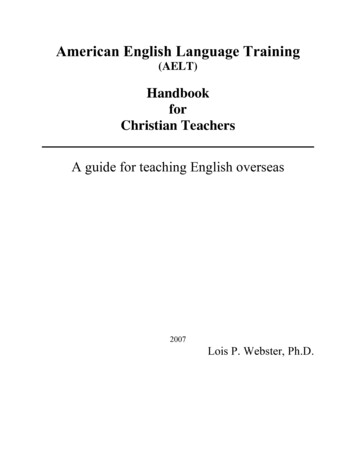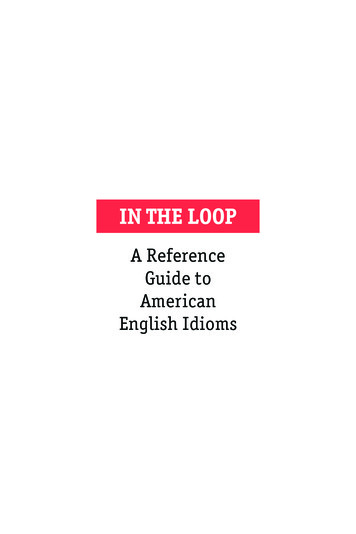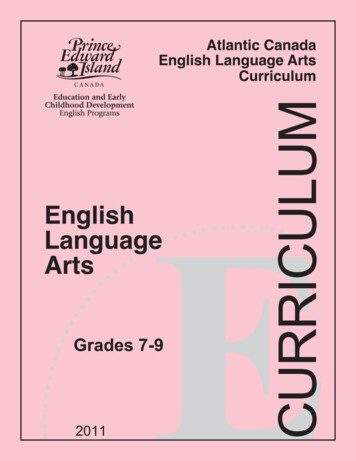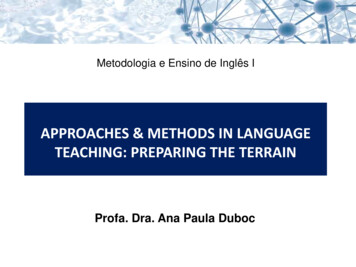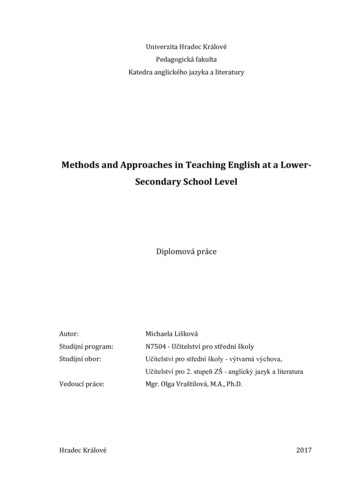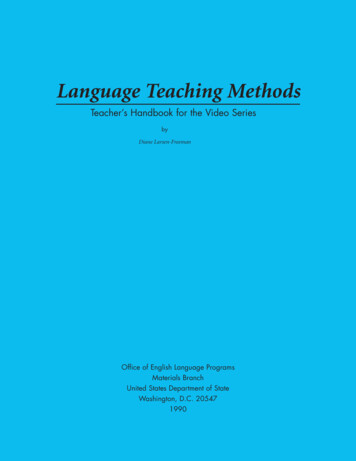
Transcription
Language Teaching MethodsTeacher’s Handbook for the Video SeriesbyDiane Larsen-FreemanOffice of English Language ProgramsMaterials BranchUnited States Department of StateWashington, D.C. 205471990
Teacher’s Handbook for the Video SeriesLanguage Teaching MethodsbyDiane Larsen FreemanOffice of English Language ProgramsMaterials BranchUnited States Department of StateWashington, D.C. 205471990
PREFACEThis video series featuring live demonstrations of current methods of teaching English as a second languagehas been produced in the USIA WORLDNET studios in Washington, D,C. The teaching materials which formthe basis for these six unrehearsed classroom lessons were created by Prof. Diane Larsen Freeman of theSchool for International Training (SIT) in Brattleboro, Vermont and appear in her book Techniques andPrinciples in Language Teaching (Oxford 1986).The six studio instructors, each a specialist in the method/approach being demonstrated, are staff membersfrom Prof. Larsen Freeman’s MA Program for Teacher Education at SIT: Michael Jerald (Audio LingualMethod); Bonnie Mennell (Community Language Learning); Kathleen Graves (Total PhysicalResponse/Comprehension Approach); Lisa Sparrow (Suggestopedia); Donald Freeman (Silent Way); AlexSilverman (Communicative Approach).As you view the scenes representative of the various methodologies, you will notice that the teachers use anumber of practical, tried and true techniques that can actually be applied in classrooms around the world,no matter what methodology is being followed. Consideration of why/why not the techniques may be help ful for you should generate much thoughtful discussion in your workshop sessions. As Prof. Larsen Freemanhas urged, keep an open mind and select those ideas that may be useful for your own teaching purposes.In this accompanying Teacher’s Handbook, you will note that each of the six units contains the video tran script of the author/director’s commentaries, the demonstrator’s lesson plans, suggestions for workshop activ ities, and additional classroom teaching techniques (Extension of the Demonstration Lesson:Interactive/Communicative Activities). This appended material contains a wealth of innovative but practicalideas that may be used effectively with large or small groups, quite apart from the video activities or method ology.On a personal note, the English Language Programs Division staff members who assisted during the video taping of this series found the experience altogether exciting and inspiring. First of all, the 45 internationalstudents (who gamely volunteered to be part of the studio classes) represent over a dozen countries, cultures,and linguistic backgrounds from around the world. As you will see, the studio cameras capture a multitudeof responses and expressions on their faces — evidence of total involvement in the innovative pair work andgroup activities. They seemed totally relaxed (for the most part! and thoroughly enjoying themselves; this,too, is dramatically visible through the eye of the camera.We believe that much of the secret to this effective teaching/learning is due to the fact that the instructorsmake every effort to avoid being threatening or confrontative, and every effort to be encouraging and rein forcing. They, too, reported that the studio sessions were a “great experience” for them. We hope you willenjoy them as well and find new inspiration for your own teaching.Anna Maria MalkoçChief, Materials Branch
TABLE OF CONTENTSLANGUAGE TEACHING METHODS VIDEO ONE: Introduction [Diane Larsen Freeman] .1I. AUDIO LINGUAL METHOD: Introduction [Larsen Freeman] .AUDIO LINGUAL METHOD: Materials [Michael Jerald] .Video Demonstration Lesson Plan .Teacher Training Discussion Questions .Teacher Training Activities .Extensions of the Demonstration Lesson .233456II. COMMUNITY LANGUAGE LEARNING: Introduction [Larsen Freeman] .COMMUNITY LANGUAGE LEARNING: Materials [Bonnie Mennell] .Video Demonstration Lesson Plan .Teacher Training Discussion Questions .Teacher Training Activities .Extensions of the Demonstration Lesson .91111121314III. COMPREHENSION APPROACH/TPR: Introduction [Larsen Freeman] .COMPREHENSION APPROACH/TPR: Materials [Kathleen Graves] .Video Demonstration Lesson Plan .Teacher Training Discussion Questions .Teacher Training Activities .Extensions of the Demonstration Lesson .182020222223LANGUAGE TEACHING METHODS VIDEO TWO: Introduction [Diane Larsen Freeman] . 25IV. SUGGESTOPEDIA: Introduction [Larsen Freeman] .SUGGESTOPEDIA: Materials [Lisa Sparrow] .Video Demonstration Lesson Plan .Teacher Training Discussion Questions .Teacher Training Activities .Extensions of the Demonstration Lesson .262727292930V. SILENT WAY: Introduction [Larsen Freeman] .SILENT WAY: Materials [Donald Freeman] .Video Demonstration Lesson Plan .Teacher Training Discussion Questions .Teacher Training Activities .Extensions of the Demonstration Lesson .323434373739VI.COMMUNICATIVE APPROACH: Introduction [Larsen Freeman] .COMMUNICATIVE APPROACH: Materials [Alex Silverman] .Video Demonstration Lesson Plan .Teacher Training Discussion Questions .Teacher Training Activities .Extensions of the Demonstration Lesson .414343454647
VII. VIDEO TRANSCRIPTS .Audio-Lingual Method .Community Language Learning .Comprehension Approach .Suggestopedia .Silent Way .Communicative Approach .51525354575859
LANGUAGE TEACHING METHODS: VIDEO ONEVideo Introduction: Hello! My name is Diane Larsen-Freeman. I’m a teacher educator at the School forInternational Training.It is common in language teacher education programs to survey current language teaching methodologies.At SIT, we do this by giving our teacher trainees a direct experience with each method. The purpose of thisvideotape series is to provide you with a similar, though vicarious, experience involving six common methods: the Audio-Lingual Method, Community Language Learning, the Comprehension Approach [on VideoOne], Suggestopedia, the Silent Way, and the Communicative Approach [on Video Two].The intermediate-level lessons you will observe were taped at the WORLDNET television studios of the USIAin Washington, D.C. and it is through the courtesy of the USIA that this program is being made available toyou. The students were all volunteers who were studying English at the time. The instructors are experiencedlanguage teachers and teacher educators from SIT who have each taught students in various parts of theworld, using the methods they will demonstrate for you here.For the sake of coherence, the instructors have designed their lessons around a common theme — namely,that of a house. What you will see are somewhat condensed versions of the original lessons. All of the stepsof the lesson have been preserved, but some of the participation has been trimmed in the interest of time.The instructors have tried to faithfully depict each method but, of course, each instructor is also putting theprinciples into practice based upon his or her interpretation and experience.I will introduce each method. Next you will observe the method in practice. Afterwards, I will point out someof the salient principles and techniques associated with each method. The lessons are meant only to introduce you to these methods. All of the methods have a richer repertoire of principles and techniques than canbe fully portrayed here. If you wish to learn more, you may choose to consult my book Techniques andPrinciples in Language Teaching published by Oxford University Press.As you view the tape, try to remain open to what you see. You may be missing out on something valuableif you reject any of the things you observe in these lessons because you don’t see how they could apply toyour own situation. For example, there were about 25 students participating in these lessons. Your own classes may be much larger than these. Rather than thinking, “This will never work with a large class,” thinkinstead, “Is there anything worthwhile for me in this technique? And if the answer is affirmative, next askyourself: “How can I adapt this technique to my own circumstances?” or “What other way can I put this principle into practice?” Let your imagination create the possibilities for you.[End of Introduction]1
I. AUDIO LINGUAL METHOD: Introduction by Diane Larsen Freeman1. Language learning is a process of habit formation.2. It is important for teachers to prevent student error since errors can lead to the formation ofbad habits.3. Students should overlearn the sentence patterns of the target language.4. Positive reinforcement helps students to develop correct habits.Video Presentation: The first method we will observe is the Audio Lingual Method or ALM. It is a method withwhich many of you may already be familiar. My colleague, Michael Jerald, will now demonstrate the ALM.Watch carefully what the teacher is doing and what he is asking the students to do.[Video Demonstration of Audio Lingual Method by Michael Jerald: See Audio Lingual Method Materialsfollowing Commentary.]Video Commentary: As the lesson began, we saw the teacher presenting a dialogue to the class. The stu dents just listened to the teacher at first. One of the ALM teacher’s major roles is that of a model of the tar get language. It is the students’ job to repeat as accurately as they can the teacher’s model. Language learn ing is seen to be a process of habit formation. The more often the students repeat something, the strongerthe habit and the greater the learning.We saw how the students stumbled over one of the lines of the dialogue they were repeating. When thishappened, the teacher used a backward build up drill with the troublesome line. He started at the end of thesentence, and had the students repeat the final phrase. To this he added each phrase in turn until the stu dents were able to say the whole sentence smoothly.The teacher corrected the students’ errors in other ways as well, for example, by quickly saying the phrasefor the students to hear and repeat. It is important to prevent learners from making errors since errors leadto the formation of bad habits.Later in the lesson, the teacher uses grammar drills: a single slot substitution drill and a question and answerdrill. These drills help students to learn, or even better to “overlearn” the sentence patterns of the target lan guage. The overlearning leads to automaticity.You may have noticed that the teacher often said “Good” or “Very good.” In this way, he positively rein forced his students’ work. Such reinforcement helps the students to develop correct habits. It wasn’t until theend of the lesson that the students got to see the written version of the dialogue which they were learning.This is consistent with the ALM principle that speech is more basic to language than the written form.[End of Commentary]2
AUDIO LINGUAL METHOD: Materials by Michael JeraldVIDEO DEMONSTRATION LESSON PLANTeaching Points1. Vocabulary:cleanamazingvacuum cleanerprettylawn2. Grammar:Using the modal combination would likeUsing the superlative degree3. Expressions:Yes, of course.Oh, no I don’t!Why not?Oh. (to express disappointment)4. Cultural point: It isn’t unusual for men to do housework in the United States.Objectives1. The students will be able to recite the dialogue from memory with few or no mistakes.2. The students will learn all of the new vocabulary items and be able to use them when reciting thedialogue and doing the grammar drills.3. The students will be able to do the grammar drills smoothly, quickly, and without mistakes.4. The students will realize that sometimes men do the housework in the United States.Video Lesson Steps in Sequence[Dialogue Practice]1. The teacher sets the scene for the dialogue and tells what he is going to do and what the studentsshould do.2. The teacher acts out the dialogue using pictures, gestures, and props.3. The teacher acts out the dialogue again, in the same manner as above.4. The teacher leads the students in repetition drills, one line of the dialogue at a time. When theteacher thinks the students have practiced a particular line enough, he goes on the next line but first3
he goes back to the beginning and has the students recite all of the dialogue they have practiced tothat point.5. The teacher and students practice the dialogue by roleplaying it. First the teacher plays the role ofThe Salesman; the students are The Woman. Then they change roles and the teacher is the Womanand the students are The Salesman.6. The teacher asks two students to come to the front of the class and act out the dialogue, using props.Then, two more students do the same thing, and so on, depending on the time allowed.[Grammar Practice]7. For the Single Slot Substitution Drill, the teacher says the whole sentence with each substitution. Thenthe teacher gives the substitution phrase only; the students say the whole sentence:Would you like to have the cleanest house in town?the prettiest housethe greenest lawn8. For the Question Answer Drill, the teacher asks the questions, the students answer. Then the studentsask the questions; the teacher answers.9. The teacher gives the students a written copy of the dialogue. Then the teacher says each line; thestudents repeat while reading.10. The teacher gives the students a homework assignment for the next class:— Memorize the dialogue so they can say it perfectly.— Sell a vacuum cleaner. (This, of course, was a joke.)TEACHER TRAINING DISCUSSION QUESTIONS BASED ON THE VIDEO1. How does the teacher teach the meaning of the dialogue?2. Why does the teacher tell the students to listen and not to talk during Steps 2 and 3 of the lesson?3. The teacher almost always says a word, phrase, or sentence immediately before the students say it.Why?4. How does the teacher correct the students’ mistakes? Why do you think it is done in this manner?5. Where did the teacher first use the “backward build up” technique? This is the technique in which theteacher has the class learn the longer sentence by repeating small parts of the sentence, startingfrom the end and working toward the beginning until the students were saying the whole sentencefrom the beginning. What is the purpose of this technique? How, exactly, is it done?4
6. In Step 4 of the lesson, how well did the students have to be able to say each line before the teacherwent on to the next line? What do you think the teacher was looking for in the students’ performance?7. Where in the lesson did you see the students do choral (the whole class in unison) repetitions? Whatother forms of repetition did you see? What pattern in the use of these forms did you see? Whatpurpose do you think this pattern served?8. What role does the teacher play while the students are acting out the dialogue in Step 6? What doesthe teacher do when a student has trouble remembering the words or makes a mistake?9. When does the teacher introduce the gestures that go with the dialogue? When does the teacher firsthave the students practice them? What is the students’ reaction? Does using the gestures help orhinder the students’ learning? Why?10. What do you think the students learned in this lesson? What does “to learn” mean in the context ofthis lesson (in keeping with audio lingual principles)? How does this match your definition oflearning?11. To what extent do the students take the initiative to speak during the lesson? That is, do they decidewhen they will speak and what they will say, or does the teacher, or is it a combination of the two?Why is it that way?12. Why does the teacher wait until the end of the class to show the students the dialogue in writing?Why does the teacher give the students the dialogue in writing at all?TEACHER TRAINING ACTIVITIES BASED ON THE VIDEOWatch the lesson on the tape again and list as many examples of when and how the teacher exercised con trol. (Under what circumstances? Using what techniques?) Keeping in mind that control of all aspects of thelesson by the teacher is very important to the success of this method, discuss your findings with a colleague.Concentrate on mastering the techniques the teacher used in Steps 2, 4, and 7 of the lesson. Work with asmall group of your colleagues, one step at a time, in the following manner, until you gain confidence inyour ability to do it smoothly:[Peer Teaching]1. Watch the section of the tape containing the part of the lesson you have chosen to work on. Make alist of everything you see the teacher doing and saying. Repeat this until you have a reasonably com plete description of what the teacher did and how he did it.2. Practice teaching this part of the lesson to your colleagues. Imitate the teacher on the tape as closelyas possible.3. Ask your colleagues to tell you what you did right and what you need to change. Then do it again.5
4. After each of you has had a chance to practice teaching this part of the lesson, watch the tape againand see what more you can learn this time.5. Discuss other possible ways of doing the Question Answer Drill (Step 7). For example, haveindividual students ask each other the questions.6. Write your own mini dialogue (3 to 5 lines) and practice teaching it to your colleagues. After you fin ish, ask your colleagues to help you evaluate what you did on the basis of clarity and on its consis tency with audio lingual principles.EXTENSIONS OF THE DEMONSTRATION LESSON:INTERACTIVE/COMMUNICATIVE ACTIVITIESInteractive and communicative activities, as we define them today, are not traditionally part of anAudio Lingual lesson. The following suggestions for expanded activities, therefore, are not necessarily inter active or communicative.[Reading Passages]1. Select a short passage about a different topic but one that contains the same grammar points and/orvocabulary items. (You can write it yourself or find one in a book.)2. Prepare the students by reviewing the grammar (through substitution and other drills) and teachingany new vocabulary items that might be in the story.3. Read each sentence before the students do, to set a correct model for them to imitate.4. Have the students read out loud to practice their pronunciation and intonation. Be sure to correct anymistakes as soon as they are made.5. Follow the same pattern as used in teaching the dialogue, by starting with choral repetitions, thengroup repetitions, and then individual repetitions. Let individual students read out loud without yourfirst modeling the sentences, but continue to correct their mistakes immediately.6. Ask comprehensive questions of individual students.[Controlled Writing]The students can do a controlled writing exercise about housework.1. Use the video lesson dialogue or write one based on the same format. While preparing, leave blankspaces for some of the words (as in a cloze test).6
2. Give the students a copy, or write it on the board, or dictate it. Ask them to write the whole dialogue,filling in the blanks as they go along.[Creative Story Telling/ Writing]With your guidance, the students can create their own stories. Start by setting the topic (in this case,housework).1. Give one student a word that will begin the story. The first student says the first word of the story; thesecond student then repeats the first word and adds one of his/her own; the third student starts at thebeginning, repeating the first and second words, and then adds another one, and so on. Taking turnsin this manner, the students build the story as it progresses around the room.2. Make sure that the story makes sense, and that the grammar and pronunciation are correct. Makecorrections immediately. Help students who are stuck to come up with a word. Keep it light and fun.3. After the story has gone around the room once, ask the students to dictate the story to you. After youwrite it on the board, they can write it in their notebooks. In large classes, you can work with groupsof 12 to 15 at a time while the others observe and take notes.[Minimal Pairs Pronunciation Practice]For special pronunciation practice with difficult sounds, you can do a minimal pair drill with the students.Depending on the native language of your students, of course, a good pair to follow up this lesson wouldbe the vowel sounds in lawn and loan.For teachers new to the field, a basic minimal pair drill is the practice of pairs of words that have exactlythe same sounds except for one sound which is different in the pair (for example, lawn/loan). Spanishspeakers, for instance, often have trouble differentiating between the /i/ and /iy/ sounds in ship and sheep.An example of a minimal pair drill for speakers of Spanish learning English then might contain the following:ship/sheep; lip/leap; hip/heap; dip/deepLearners from other language backgrounds have various problems differentiating between pairs like thin/tin;lake/rake; pin/bin; wine/vine; sing/sink; pool/pull, etc. You can easily prepare your own minimal pair listin the following way:1. Make up a short list of word pairs, selecting words which the students already know, if possible.Remember to choose word pairs that contain only one different sound. Ask yourself: Does it change the meaning of the word if this sound is not pronounced correctly? Are your students having trouble pronouncing this sound? Do the word pairs match exactly except for this one special sound?7
2. Now, model the words for your students, pronouncing them first individually and then in pairs. Askthe students to repeat after you. In this way, they can learn to hear them correctly and to say themcorrectly. (For beginning students it is helpful to have visual aids to illustrate the words.)[Charades]Practice getting the meaning of words and phrases across through demonstrating and acting, an importantand useful technique for this method. You can practice by playing a variation of charades with your col leagues as follows:1. Choose vocabulary items, phrases, or expressions that are in the classroom text or curriculum you use(instead of movie or book titles).2. Play with two teams, A and B. Each team writes words, phrases, etc., on small pieces of paper (oneitem per piece of paper).3. Players fold the pieces of paper so that they can’t be read, and put them in two small containers —a hat or box, for example.4. One person from Team A chooses a piece of paper from Team B’s pieces of paper. He or she thenhas three minutes to act out the meaning of what is written on the paper for his or her own teammates. The object is for the team to guess the word that is written on the paper within the three minutetime limit. If he or she succeeds, then that player’s team gets one point.5. Then, it is Team B’s turn to have a representative take a piece of paper from Team A’s collection andact it out for his or her team. The meaning can be communicated in any way except by speaking,writing, or pointing to the object itself.[End of Lesson Materials]8
II. COMMUNITY LANGUAGE LEARNING: Introduction by Diane Larsen Freeman1. Students are whole persons.2. People learn best when they feel secure.3. Students should have the opportunity to generate the language they wish to learn.4. The teacher should “understand” what the students are feeling.Video Presentation: Next, we will see a demonstration of a method called Community Language Learningor CLL. Based upon the more general Counseling Learning approach to adult education developed byCharles Curran, CLL calls upon teachers to become skillful “understanders” of their students as “whole per sons.” Becoming a skillful understander means recognizing and accepting the struggles students face as theyattempt to internalize another language. Watch how “whole person learning” is put into practice in the CLLdemonstration lesson by my colleague Bonnie Mennell.[Video Demonstration of Community Language Learning by Bonnie Mennell:See CLL Materials following Commentary]Video Commentary: You may have noticed that the teacher began the lesson by telling students what theywere going to be doing for the class. The teacher does this, recognizing that any new learning experiencecan be threatening. When students have an idea of what will happen in class, they often feel more secure.People learn best when they feel secure.What came next in the lesson was the teacher’s inviting the students to first visualize and then to describetheir homes. Each student was given a time limit and towards the end of the activity was reminded that theyhad only one minute left. Setting and enforcing time limits also enhances student security.Afterwards, they listed the words they needed for the descriptions. Curran believed that students should begiven an opportunity to assert themselves, to be actively involved, and to invest themselves in the learningexperience. One of the ways of allowing for this is for the students to have the responsibility for generatingthe language they wish to learn or to work on.The students next inquired about the meaning and practiced the pronunciation of the words they had listed.You may recall that the teacher stood behind the students as she read the words after them. This is done inthe belief that the superior knowledge and power of the teacher can be threatening. If the teacher does notremain in the front of the classroom, the threat is reduced and the students can focus their full attention onthe words in front of them.When the students practiced the words individually, they chose which words they wished to have the teacherrepeat, an exercise termed the “Human Computer.” The students control the computer; they can turn the com puter off anytime. The students learn to discriminate: to listen carefully to see if what they are saying match es what the teacher is saying.9
The students were next asked to use the new words to make their own sentences. As the teacher repeatedeach student’s sentence, she corrected it — never overtly, but rather by repeating the sentence correctly ina nonthreatening manner.The last part of the lesson was devoted to a feedback session in which the students reflected on what theyhad experienced and felt during the lesson. The teacher listened and showed each student she understoodwhat each one was feeling. In this way, students have an opportunity to feel accepted as whole persons, tolearn about their own learning, in addition to learning about the language.[End of Commentary]10
COMMUNITY LANGUAGE LEARNING: Materials by Bonnie MennellVIDEO DEMONSTRATION LESSON PLANTeaching Points1. Meaning and pronunciation of student generated vocabulary for describing the house.Objectives1. Students will generate, clarify the meaning of and practice the pronunciation of a list of vocabularywords needed to describe the house.2. Students will create an image of their home in a fellow student’s mind through words.3. Students wil
Language Teaching Methods Teacher’s Handbook for the Video Series by Diane Larsen-Freeman Office of English Language Programs Materials Branch United States Department of State Washington, D.C. 20547 1990. Teacher’s Handbook for File Size: 514KB
